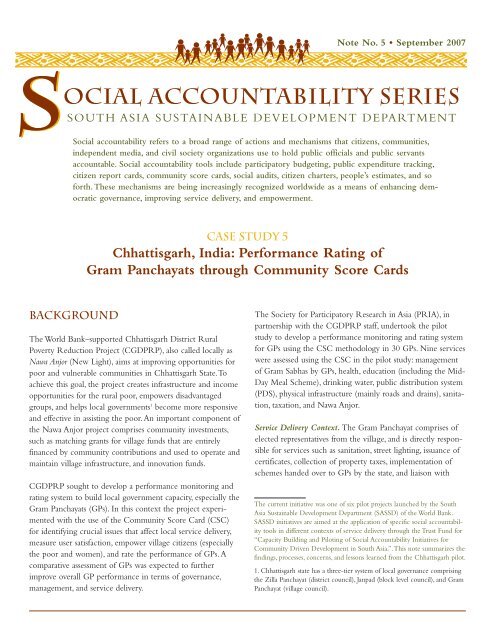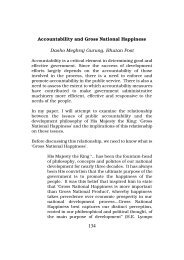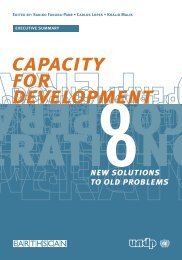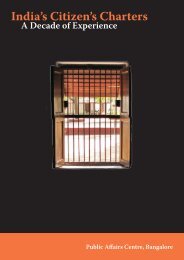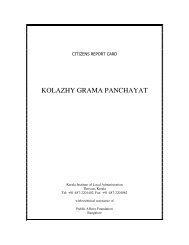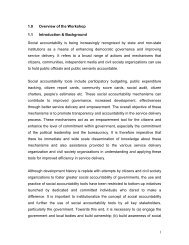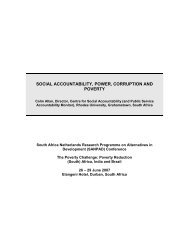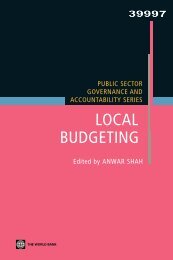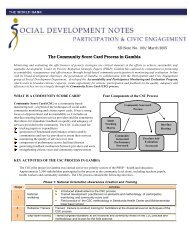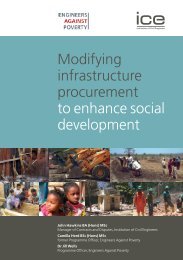Community Score Cards - SASANet
Community Score Cards - SASANet
Community Score Cards - SASANet
- No tags were found...
Create successful ePaper yourself
Turn your PDF publications into a flip-book with our unique Google optimized e-Paper software.
Note No. 5 • September 2007OCIAL ACCOUNTABILITY SERIESSOUTH ASIA SUSTAINABLE DEVELOPMENT DEPARTMENTSocial accountability refers to a broad range of actions and mechanisms that citizens, communities,independent media, and civil society organizations use to hold public officials and public servantsaccountable. Social accountability tools include participatory budgeting, public expenditure tracking,citizen report cards, community score cards, social audits, citizen charters, people’s estimates, and soforth. These mechanisms are being increasingly recognized worldwide as a means of enhancing democraticgovernance, improving service delivery, and empowerment.Case Study 5Chhattisgarh, India: Performance Rating ofGram Panchayats through <strong>Community</strong> <strong>Score</strong> <strong>Cards</strong>BACKGROUNDThe World Bank–supported Chhattisgarh District RuralPoverty Reduction Project (CGDPRP), also called locally asNawa Anjor (New Light), aims at improving opportunities forpoor and vulnerable communities in Chhattisgarh State.Toachieve this goal, the project creates infrastructure and incomeopportunities for the rural poor, empowers disadvantagedgroups, and helps local governments 1 become more responsiveand effective in assisting the poor. An important component ofthe Nawa Anjor project comprises community investments,such as matching grants for village funds that are entirelyfinanced by community contributions and used to operate andmaintain village infrastructure, and innovation funds.CGDPRP sought to develop a performance monitoring andrating system to build local government capacity, especially theGram Panchayats (GPs). In this context the project experimentedwith the use of the <strong>Community</strong> <strong>Score</strong> Card (CSC)for identifying crucial issues that affect local service delivery,measure user satisfaction, empower village citizens (especiallythe poor and women), and rate the performance of GPs. Acomparative assessment of GPs was expected to furtherimprove overall GP performance in terms of governance,management, and service delivery.The Society for Participatory Research in Asia (PRIA), inpartnership with the CGDPRP staff, undertook the pilotstudy to develop a performance monitoring and rating systemfor GPs using the CSC methodology in 30 GPs. Nine serviceswere assessed using the CSC in the pilot study: managementof Gram Sabhas by GPs, health, education (including the Mid-Day Meal Scheme), drinking water, public distribution system(PDS), physical infrastructure (mainly roads and drains), sanitation,taxation, and Nawa Anjor.Service Delivery Context. The Gram Panchayat comprises ofelected representatives from the village, and is directly responsiblefor services such as sanitation, street lighting, issuance ofcertificates, collection of property taxes, implementation ofschemes handed over to GPs by the state, and liaison withThe current initiative was one of six pilot projects launched by the SouthAsia Sustainable Development Department (SASSD) of the World Bank.SASSD initiatives are aimed at the application of specific social accountabilitytools in different contexts of service delivery through the Trust Fund for“Capacity Building and Piloting of Social Accountability Initiatives for<strong>Community</strong> Driven Development in South Asia.”.This note summarizes thefindings, processes, concerns, and lessons learned from the Chhattisgarh pilot.1. Chhattisgarh state has a three-tier system of local governance comprisingthe Zilla Panchayat (district council), Janpad (block level council), and GramPanchayat (village council).
various departments for other functions such as health services,education, and water supply. GPs are also expected tosupervise and monitor services and schemes run by otherdepartments, in collaboration with special-subject village-levelcommittees. For example, the Village Education Committee(VEC) is supposed to supervise all education activities in thevillage and the Village Water Supply Committee (VWSC) issupposed to monitor all village drinking water supply sources/schemes and liaise with the Public Health EngineeringDepartment (PHED).Accountability Context. The GP is accountable to the GramSabha 2 for all its actions.This is the only channel of “downwardaccountability” at the village level. In areas/programs such asorganizing Gram Sabhas, drinking water supply, sanitation, andsmall infrastructure works, the GP is primarily responsible forservice delivery. For Nawa Anjor, the GP is responsible for managingall village-level activities including fund management. Forservices such as health, education, midday meals, and ration distributionthrough the PDS, village-level committees or the GPdo not have any direct control over the actual service providers.The service providers are upwardly accountable to their superiorsin the respective line departments and downward accountabilityin any form is very weak. It was in this context that theNawa Anjor project wanted to develop an approach that couldmake service providers more accountable to the villagers for allvillage-level services.PROCESSThe Methodology. The CSC process can be divided into sixkey stages (figure 1): (i) preparatory groundwork, (ii) developingthe input-tracking score card, (iii) generation of thecommunity performance score card, (iv) generation of theself-evaluation score card by facility/project staff, (v) the interfacemeeting between community and providers, and (vi) thefollow-up process of institutionalization.The pilot was conductedin two phases, the first in two districts (Raigarh andBilaspur) in February 2006 and the second in the remainingdistricts in March 2006.GP Sample Selection. Thirty GPs from 14 blocks in 7 districtsout of a total of 2,046 GPs from the central, north, and southregions of the state were selected for the pilot study. A multistage,stratified, random sampling technique was used to identifythe 30 GPs. Selected districts exhibited high cultural andsocioeconomic variations.Tribal and non-tribal blocks, as wellas remote and proximate blocks to district headquarters, were<strong>Community</strong> <strong>Score</strong> <strong>Cards</strong>The CSC is a community-based monitoring toolthat is a hybrid of the techniques of social auditand citizen report cards.The CSC is an instrumentto ensure social and public accountability andresponsiveness from service providers. By linkingservice providers to the community, citizens areempowered to provide immediate feedback.included in the sample.The final identification and selectionof GPs in each block was made in consultation with the ProjectFacilitation Team (PFT) and ensured the inclusion of single/multiplevillage(s) GPs, tribal/non-tribal Sarpanches, 3 andwomen Sarpanches in the selected sample.Social Profile of Pilot Districts. The population of the 30 GPsselected for the pilot was 52,975.The Scheduled Tribe (ST)and the Scheduled Caste (SC) populations in the pilot districtswere 47 percent and 19 percent respectively.The overall literacylevel of the population averaged 51 percent, with DantewadaDistrict in the south having the lowest literacy level of15 percent.The average male/female ratio in the pilot GPswas 1,010, while the average family size was five.Field Research. Select staff from PRIA’s partner organizationswith extensive grassroots experience and an understanding ofparticipatory research methodologies were identified acrossdifferent regions in Chhattisgarh.Three Field Research Teams(FRTs), one for each region, composed of a field supervisorand three field investigators, were selected for conducting thepilot study.The FRTs were trained in the CSC methodology.Field research was carried out in two phases. In phase one, afield investigation plan detailing the investigation schedule,roles and responsibilities of each FRT member, the samplingplan, and methodology for conducting CSCs was made.Theresults of the first phase of field investigations in Raigarh andBilaspur districts were discussed with the World Bank andNawa Anjor project staff to assess whether outcomes met projectrequirements. Based on these discussions, the second phaseof the field research produced a field manual to assist FRTs2.The Gram Sabha is the Village Assembly, comprising of all adults residingin the village.3.The Sarpanch is the elected head of the GP in the three-tier system ofdemocratic decentralization in India.2
and appropriate modifications to the field investigation planwere made.The criteria, the indicators, and the priority sectorsfor GP ratings were generated during the first phase offield research through discussions with the communities andCGDPRP staff.The FRTs were in constant touch with bothproject staff and Panchayat members.Input Tracking. The FRT collected supply-side data on servicesbeing offered by the GP.These data included budgetaryallocations and entitlements of each village in the GP undervarious schemes, such as toilets under the Total SanitationCampaign (TSC); houses under the Indira Awas Yojana (IAY);quantity of rations through the Public Distribution System(PDS); handpumps under the Drinking Water Supply Scheme;cement concrete roads and Panchayat Bhawans constructedunder CGDPRP; and books distributed and classrooms constructedunder the Sarva Shiksha Abhiyan (SSA). Subsequently,the data was discussed with participating community membersand actual progress under each scheme was physically verifiedand recorded.<strong>Community</strong> Assessments. The GP ratings were done primarilythrough Focus Group Discussions (FGDs). In the 30 selectedGPs, 4,347 people (8.21 percent) out of a total population of52,975 participated in the FGDs. A preliminary stratificationof the community on the basis of usage of various services,participation in Gram Sabha meetings, poverty, landholding,and overall socioeconomic conditions assisted the FRT inconducting FGDs on homogenous groups.Three or fourfocus groups of 15–20 members each, comprising adult men,adult women, village elders, and Common Interest Group(CIG) members, were formed in each GP. All GP membersand officials were excluded from the FGDs to avoid biases.Each focus group awarded relative scores on a scale of 0–10(higher score being “better”) to each of the indicators andgave reasons for the scores.The groups also provided suggestionsfor improving poor performance resulting in low scores.After the FGDs, a common meeting was held to prioritizeindicators and identify practical solutions to existing problemscollectively.Two indicator scoring techniques were used: (i) anFigure 1. Stages in the <strong>Community</strong> <strong>Score</strong> Card ProcessSTAGE – 1Preparatory Activities(Selection of resource persons; training design,training workshops, field visits, planning)STAGE – 2Input TrackingInput Tracking <strong>Score</strong> CardSTAGE – 3<strong>Community</strong> Assessment<strong>Community</strong> GeneratedIndicators & <strong>Score</strong> <strong>Cards</strong>STAGE – 4Self Evaluation by Service ProvidersSelf-Evaluation<strong>Score</strong> <strong>Cards</strong>STAGE – 5Interface MeetingAction PlanSTAGE – 6Post Implementation Activities(Analysis; advocacy; dissemination’ policy changes)3
average group score was assigned through the use of stones ormarbles, and (ii) a weighted average group score was assignedby facilitators by categorizing individual responses into fivescoring categories (0–2 for poor, 3–4 for below average, 5–6for average, 7–8 for good, and 9–10 for excellent) and theweighted average of the responses was computed.Self-Evaluations. The elected representatives and officials ofthe GP scored the indicators identified earlier using the same10 point scale, separately stating reasons for low and highscores. Suggestions to improve poor performance were alsorecorded during the process.Interface Meetings. The results of the community assessmentand self-evaluation score cards were shared in an interfacemeeting attended by both community and GP members.Allscore cards were displayed at the venue of the meeting.A dialoguebetween the community and the GP members, facilitatedby the FRT members, assisted participants in generating a finalscore card along with a list of actions to be implemented by theGP.The final set of common indicators for rating all GPs generatedafter completing the FGDs in all 30 sampled GPs is specifiedin Annex 1.This set of indicators forms the basis for acomparative assessment of GP performance.KEY RESULTS1. Identifying priority sectors and performance indicators. Thepilot study assisted the community in identifying priority sectorsand performance indicators in each of the 30 GPs.Thepriority sectors identified by the community during the FGDsand interface meetings were organizing Gram Sabhas, tax collection,health, education, drinking water, rations through thePDS, and Infrastructure projects.2. Recognizing key problems and identifying their solutions.The CSC process enabled the recognition and documentationof major problems in various service delivery contexts.Thisled to constructive problem solving in the interface meetings,in which various innovative solutions were proposed by thecommunity and accepted by GP members and officials. Anillustrative list of issues identified by community members,reasons for dissatisfaction, and agreed action points with GPs isgiven in table 1.The community also learned to appreciate theproblems faced by the service providers in some cases. Forexample, auxiliary nurse midwife (ANM) 4 visits to villageswere few and sometimes irregular because each ANM, on theaverage, had to cover 20 villages in remote and sometimesunsafe locations.This knowledge increased user satisfactionlevels for ANMs.3. Generating community awareness and increasing empowerment.One of the strengths of the CSC process is that it generatescommunity awareness and provides voice to users,which in turn empowers them. Actions such as the GP agreeingto - conduct immediate repairs to handpumps; provideinformation on tax rates in the Gram Sabha; put up displayboards displaying information on expenses on infrastructureprojects; collectively ban people under intoxication from participatingin Gram Sabhas, not only empower the communitiesbut also make the service providers directly accountable tothe communities.METHODOLOGICAL CONSTRAINTSEven though the CSC process led to a number of interestinginsights and local solutions, some limitations were observedwhile conducting the pilot.1. Duration of CSC Field Work. Due to a lack of time, thefield work in each village was completed in a day. Consequently,insufficient time for preparatory work, input trackingand discussions, and the inclusion of nonusers in the scoringprocess may have biased results. Ideally, three days should beassigned per village for the CSC process, with at least one dayfocusing on the input tracking exercise.2. Quality of Facilitation. Most facilitators who participated inthe pilot were local NGO/CBO workers who were helpingfacilitate the CSC for the first time.Their inexperienceaffected the quality of facilitation at the village level. Facilitationis key for the success of the CSC process. A comprehensivefacilitator training program is desirable for elicitingpositive community responses.3. Choice of Indicators. In the pilot, given the inexperience ofthe field surveyors, the indicators for each service were finalizedafter discussions with senior officers and CSC field trials in afew villages. Consequently the indicators used by both usersand providers were identical. In a typical CSC process, usersand providers can select different indicators independently.4.The ANM is a female health worker who is attached to the Primary HealthCenter or Sub-Center and visits villages for health outreach programs.4
TABLE 1: PROBLEM SOLVING BY COMMUNITIES (ILLUSTRATIVE EXAMPLES)S. No. Service Problems Identified Solution/RecommendationServices Managed by GP1 Organizing Lack of quorum to conduct Information about Gram Sabha to be given twice, seven days inGram Sabhas Gram Sabha advance; Kotwal should take the signatures of five people from eachhamlet after announcement of the Gram Sabha meeting; the GramSabha venue should be centrally located in a government building.Low participation by women as they are A motion to conduct a women’s Gram Sabha to be raised in nextnot informed about or not heard in GramSabha meetingsSome people attend Gram Sabha meetingsin a drunken stateDevelopment issues are not discussed inthe Gram SabhaGram Sabha; women GP members should bring women to theGram Sabha; place and date of Gram Sabha should be finalizedafter consultation with women.People should not attend Gram Sabha in an inebriated state and ifthey do they shall be punished.Information about development schemes should be disseminatedin the Gram Sabha; an agenda for the Gram Sabha should beprominently displayed.2 Infrastructure Poor and irregular maintenance of Transparency in procurement of material and amount spent by GP.projects construction works The GP should erect a board displaying information about theconstruction work at the work site.3 Taxation Lack of transparency in tax collection and Information about tax rates to be given in Gram Sabha.utilization (people not aware of the annualland tax rates being collected by GPofficer; some have paid an unofficialcollection fee of Rs. 5 per person)Services Supervised by GP through Special Committees4 Education Shortage of buildings/classrooms More classrooms should be constructed; GP should send proposalsto Block Panchayat for construction of classrooms.Irregularity of teachersVEC to monitor attendance of teachers; submit written complaintsto education department about errant teachers.5 Drinking Red-colored water due to iron contam- Inform Public Health and Engineering Department (PHED) forwater & ination from iron mining (Isku Para in remedial action.maintenanceDhurlee, Bade Kameli villages)ofhandpumpsLarge time delay in repairing HPs GP should buy and provide spare parts and tools to the local tech-(sometimes as much as 6 months) due to nicians immediately and ask them to undertake repair jobs.(HPs)a lack of technicians or spare partsInstallation of HPs without consultation GP to send proposal for additional HPs to PHED.with GP resulting in inequitable distributionof HPs in some hamletsIrregular and inadequate water supply Construct a water tank under the Nawa Anjor scheme (Mauhapalli GP).6 Health Low frequency of ANM visits to villages Arrangements for stay of the nurse will be made in the villageas ANMs had to cover an average of 20 (Gemawada Village).villages in unsafe terrainInsufficient supply of medicinesThe depot holder of the health center should come to the GramSabha and give an account of medicines used.7 Nawa Anjor Lack of awareness about scheme benefits Information about Scheme to be given in Gram Sabha; training ofGP members to be conducted.5
4. Inconsistency in <strong>Score</strong>s. Users and providers usually assignnumeric scores to identified indicators in a typical CSC exercise.Thenominal differences in community and self-evaluationscores and inconsistencies between scores and theirjustifications lead to the conclusion that numeric scores tomeasure satisfaction rating may not have been the preferredmethod for measuring performance.a. Nominal differences in community and self-evaluation scores.The difference between average community and self-evaluationscores for various services was nominal (figure 2).Themaximum difference was 1.0 in the health sector.An analysisof the indicators shows that the differences between thecommunity and self-evaluation scores for various indicatorsvaries from a maximum of 2.0 for the indicator “Regularityin Tax Collections” (implying that the community’s score washigher than the service providers) to a minimum of –1.3 forthe indicator “Transparency in Tax Collection” (implying thatthe community score was lower than the service providerscore). In 6 of the 37 indicators, the difference between thetwo scores was 0, while for most indicators (25 out of 37)the difference was less than 0.5 (Annex 1).b. Disagreement in scores and their justifications. There aremany instances in which user groups have assigned highscores (indicating high satisfaction), while the reason citedindicates poor performance. For example, in Jamwantputvillage, Sarguja district, the indicator “adequate number ofhandpumps for water supply” has been given 10/10, but thereasoning for the indicator states that the “number of handpumpsis inadequate.” Similarly in Chakki village, Sargujadistrict, the indicator “quantity of mid-day meal at primaryschool” has been given 10/10, but the reasoning states that“insufficient quantity is being given to children.”In the case of communities that are not comfortable with theconcept of scoring (such as those in this pilot), facilitatorsencourage communities to use rating scales to measure satisfaction,such as a five-point scale of excellent, very good,good, bad, and very bad, to. Alternate performance evaluationcriterion such as rating scales should have been explored inChattisgarh.KEY LESSONS AND FUTUREIMPLICATIONSThe CSC process provides voice to communities. The pilot hasestablished that, irrespective of the type of the GP (tribal, nontribal,literate, and so forth), the CSC is a powerful processthat provides voice to communities.The process clearly establishedthe kind of service improvements people expect fromthe programs in existence. For example, citizens voiced a needfor small investments in additional school rooms, repair ofnonfunctional handpumps, and so forth. No existing governmentprogram caters to such needs adequately.The infrastructuregrants component of the Nawa Anjor project couldfacilitate a process by which GPs receive untied infrastructurefunds while making GPs more accountable to communities toensure such funds are used in a judicious, transparent, and participatorymanner.The CSC process can disseminate informationto users, identify issues that affect service delivery, andempower users to negotiate immediate improvements.Incentives and disincentives to improve performance of GPsneed to be instituted. The CSC process enabled expression ofmany qualitative issues related to the governance of GPs.Thecitizens clearly articulated the drawbacks of the manner inwhich Gram Sabhas are managed today.There is a need forthe higher tiers of government to work on making the GramSabha an effective forum for self-governance. For this, there isFigure 2: Comparison of Average <strong>Community</strong> & Self-Evaluation <strong>Score</strong>s9.08.07.06.05.04.03.02.01.00.0-1.0OrganizingGrainSabhasEducationDrinkingWaterMid-dayMealSchemeInfrastructureHealthPDSDistributionNawaAnjorTaxationAverage <strong>Community</strong> <strong>Score</strong>Average Self-Evaluation <strong>Score</strong>DifferenceType of Service6
a need for capacity building across the three tiers of local governmentand incentivizing better performance. A performance-basedsystem of incentives and disincentives—such asadditional untied funds for development works for the bestperformingGPs and action in the form of withdrawal of projectbenefits from the worst-performing GPs—may helpimprove the quality of governance in GPs and institutionalizethe performance rating process.Institutionalization needs higher-level support. For institutionalizationof the CSC process, project authorities and governmentofficials need to accept and act upon the CSC-generatedaction plans. On the supply side, CBOs and citizens’ groups(such as Village Education Committees, Parent-Teachers Associations,VillageSanitation Committees, and so forth) need totrain their staff on CSC methodologies, so that a cadre oforganizations and professionals is created that can demand andundertake the CSC exercise on a sustained basis.Various directand indirect uses of the data and findings generated from theCSCs, such as the utilization of data in creating annual block,district, and state plans by disseminating CSC results into thepublic domain, may increase the acceptance, credibility, andlegitimacy of the CSC process.Solutions to local problems are generated despite handicaps.The effectiveness of the CSC depends on the levels of communityawareness and participation, the effectiveness withwhich service delivery institutions perform, and the level ofsupport from higher authorities. Exercises such as micro-planningand input tracking assist in increasing awareness and participation.Thepilot demonstrated that even if communitieswere unaware of their entitlements, lacked access to information,or were unable to score performance, constructive solutionsto local problems were generated.This demonstrates ofthe power of the CSC. However, the CSC process alsorevealed issues that were beyond the mandate of GPs. Forexample, in the education sector, most parents expressed ahigh level of dissatisfaction with the teacher’s attendance andquality of teaching.While VECs are responsible for “managingthe attendance of teachers and quality of teaching,” they donot have powers to take action against the erring teachers. Atbest,VECs can send a memorandum to the Block Panchayat.Similar problems exist with medicine distribution, visits ofhealth workers, and timely maintenance of handpumps by thePHED. In the absence of institutional/project support it is stillunclear how the agreements reached during the processshould be implemented and monitored.This situation highlightsthe need to revisit the roles of different tiers and departmentsof service providers and also the rules and regulations ofservice delivery. Roles and rules should be redesigned to makethe service provider accountable to the users either directly orindirectly through GPs.REFERENCESMalena, Carmen, with Reiner Forster and Janmejay Singh. 2004.“Social Accountability: An Introduction to the Concept and EmergingPractice.” Social Development Papers 76.Washington D.C.;World Bank, Participation and Civic Engagement Group.The Society for Participatory Research in Asia (PRIA). 2006. PerformanceRating of Gram Panchayats in Chhattisgarh, India: Draft ProjectReport. New Delhi, India.World Bank. 2004. World Development Report 2004: Making ServicesWork for Poor People. Washington DC:World Bank.7


